What Is a Lemon Squeezer
A lemon squeezer is a kitchen tool designed to extract juice from citrus fruits efficiently. You'll find various types, including handheld and countertop models, made from durable materials like stainless steel or aluminum. To use one, simply cut a lemon in half, place it cut-side down in the squeezer, and apply pressure. These devices maximize juice extraction while minimizing mess and hand strain. They're particularly useful for cooking, cocktail-making, and adding zest to dishes. When choosing a squeezer, consider factors like size, material, and ergonomic features. The evolution of lemon squeezers reflects centuries of culinary innovation and design ingenuity.
This post may contain affiliate links. If you make a purchase through these links, I may earn a commission at no additional cost to you. Additionally, portions of this post may be generated using artificial intelligence (AI) technology. While we strive for accuracy, please be aware that AI-generated content may not always be perfect and should be fact-checked when necessary.
The Spatula Scoops
- A lemon squeezer is a kitchen tool designed to extract juice from citrus fruits efficiently.
- It typically features a hinged design with a bowl-shaped bottom and a pressing mechanism on top.
- Lemon squeezers come in various materials, including stainless steel, aluminum, and plastic.
- They often include ergonomic handles, built-in strainers, and seed-catching mechanisms for ease of use.
- Modern lemon squeezers maximize juice extraction while minimizing mess and hand strain compared to manual squeezing.
Definition and Purpose
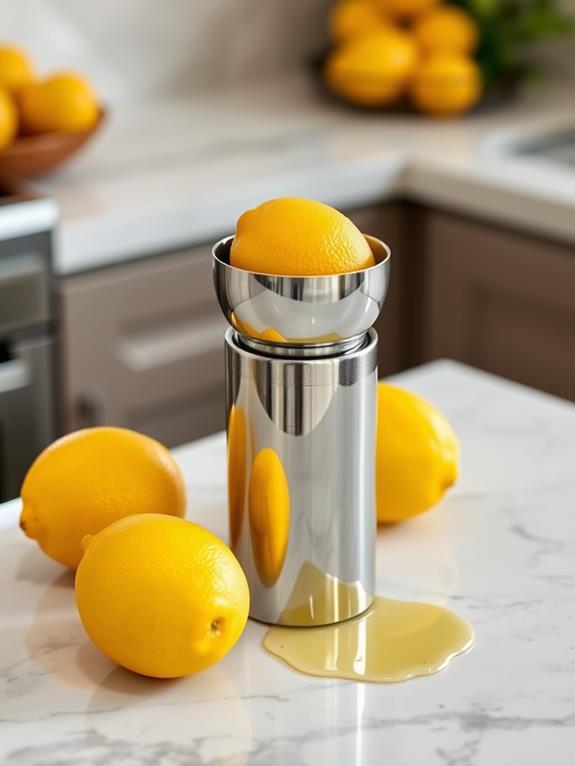
What Is a Lemon Squeezer
Definition and Purpose
When it comes to kitchen gadgets, the lemon squeezer stands out as a simple yet ingenious tool. You'll find this handy device designed specifically for extracting juice from lemons and other citrus fruits. Its primary purpose is to make the juicing process more efficient and less messy than traditional hand-squeezing methods. For instance, modern squeezers, like the KitchenAid Citrus Juice Press, come equipped with features such as a no mess mechanism that contains juice and a built-in strainer that catches pulp and seeds.
A lemon squeezer works by applying pressure to the fruit, effectively separating the juice from the pulp and seeds. You'll appreciate how it can extract more juice compared to manual squeezing, making it especially useful for cocktail preparations and cooking tasks that require precise amounts of citrus juice. Modern lemon squeezers often feature ergonomic designs to enhance your user experience and reduce hand strain.
The concept of the lemon squeezer isn't new; its roots can be traced back to 18th century Turkey. Since then, it has undergone numerous innovations, with over 200 patents filed in the U.S. between 1880 and 1910 alone. Today's models, like the Joseph Joseph Catcher, even incorporate seed-filtering mechanisms, further improving the juicing process and saving you time in the kitchen.
Types of Lemon Squeezers
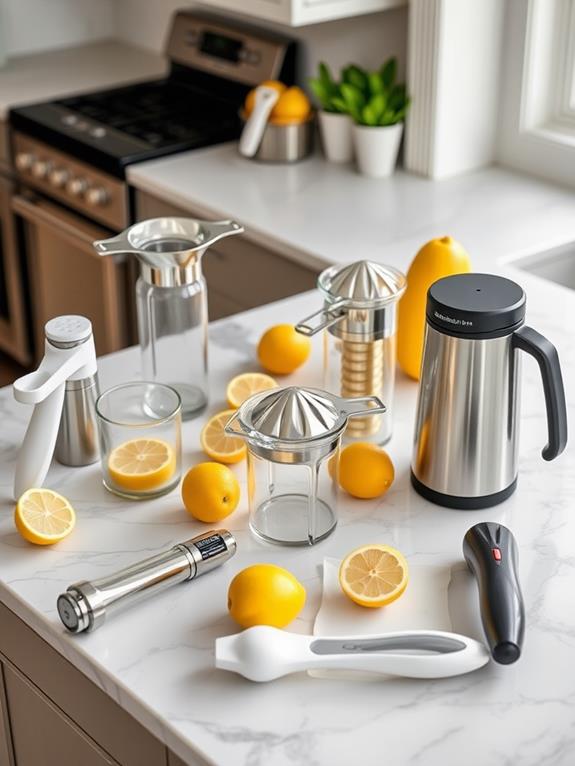
The world of lemon squeezers offers a diverse array of designs to suit various needs and preferences. You'll find handheld options that are ergonomically designed for comfort, perfect for quick juicing tasks. If you're looking to process larger batches, countertop juicers might be more your speed, though they do require more space. For example, just as the OXO Good Grips Stainless Steel Scraper & Chopper combines ergonomics with versatility, some lemon squeezers prioritize user-friendly design.
For those interested in historical designs, traditional wooden lemon squeezers have been around since at least 1857, with a notable use at Trinity College for punch-making. On the other end of the spectrum, you'll find modern innovations like the Joseph Joseph Catcher, which filters out seeds while juicing, and the Fluicer, a triangular handheld device that maximizes juice extraction.
If you're more interested in aesthetics, the iconic Juicy Salif, designed by Philippe Starck in 1990, is a prime example of form over function in lemon squeezers. For a different approach to juicing, citrus reamers use a rotating motion to extract juice. With such a wide variety of lemon squeezers available, you're sure to find one that fits your specific needs and kitchen style.
Materials and Construction
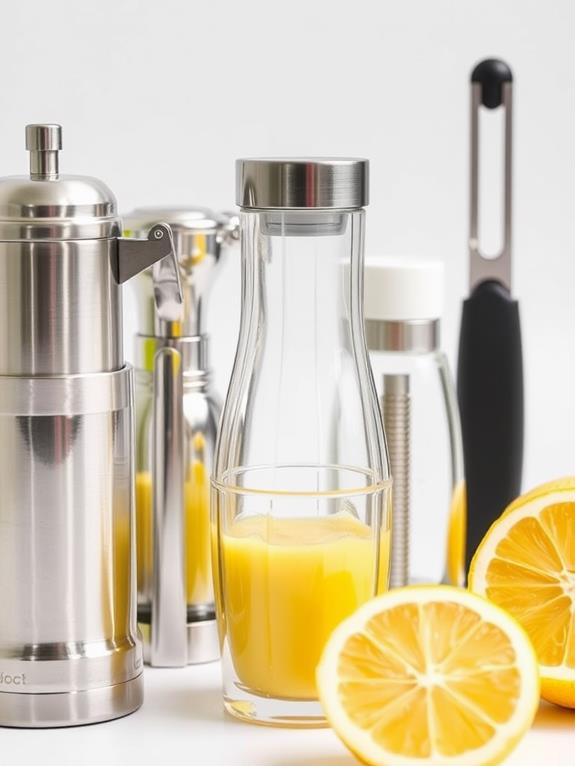
When you're looking for a lemon squeezer, you'll find that many are made from stainless steel, particularly 304-grade, which resists corrosion and rust. Some high-quality options also come with features inspired by sturdy construction and versatility, enhancing their usability for various citrus fruits. You'll appreciate the ergonomic designs that often include anti-slip silicone handles, making your juicing tasks more comfortable and efficient. These squeezers are built to last, balancing durability with user-friendly features that make them suitable for various citrus fruits while ensuring long-term performance.
Common Metals Used
For lemon squeezers, manufacturers primarily rely on two metals: stainless steel and aluminum. You'll find that stainless steel is the top choice for many high-quality squeezers. It's favored for its durability and resistance to corrosion, which is essential when dealing with acidic citrus juices. StainlessSteelMade squeezers often use top-grade 304 stainless steel, ensuring long-lasting performance and easy maintenance.
Aluminum is another popular option for lemon squeezers. It's lightweight and easily molded into various designs, making it versatile for different squeezer styles. However, aluminum may require a protective coating to prevent oxidation when exposed to citrus acids.
When you're shopping for a metal lemon squeezer, you'll notice these key features:
- Polished finishes for easy cleaning and sleek appearance
- Ergonomic designs with anti-slip silicone handles for comfort
- Sturdy construction for efficient juicing and longevity
While plastic squeezers exist, metal options generally offer superior performance. They're more efficient at extracting juice and tend to last longer. The choice between stainless steel and aluminum often comes down to personal preference, but both materials can provide excellent results when properly designed and constructed.
Ergonomic Design Features
Designed with user comfort in mind, modern lemon squeezers incorporate several ergonomic features to enhance the juicing experience. You'll find that many models boast comfortable handles with anti-slip silicone grips, ensuring a secure hold even when your hands are wet or slippery. These ergonomic design features not only improve your grip but also reduce hand fatigue during extended use.
The efficient 8-hole design you'll encounter in some lemon squeezers maximizes juice extraction by inverting the lemon peel, leaving minimal waste. This clever feature allows you to get the most out of each fruit without straining your hands. Additionally, many lemon squeezers can accommodate larger fruits, handling lemons and medium oranges up to 2.75 inches in diameter.
Here's a comparison of ergonomic features in lemon squeezers:
| Feature | Benefit |
|---|---|
| Anti-slip grips | Improved handling |
| 8-hole design | Maximum juice extraction |
| Large fruit capacity | Versatility in use |
| Polished finish | Easy cleaning |
| Stainless steel construction | Durability and corrosion resistance |
These ergonomic design features combine to create a lemon squeezer that's not only efficient but also comfortable to use, making your juicing tasks easier and more enjoyable.
How to Use Effectively
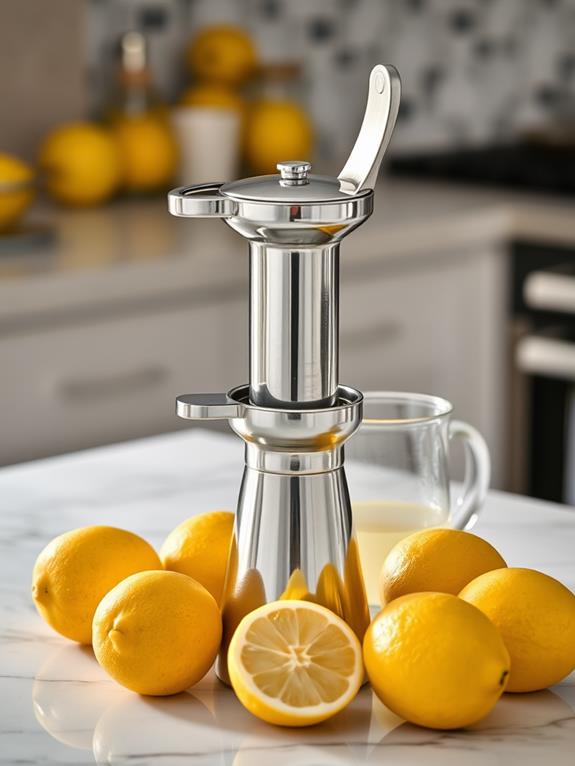
With a lemon squeezer in hand, you're ready to extract every last drop of citrus goodness. To use your lemon squeezer effectively, start by cutting the lemon vertically in half. Place one half in the squeezer with the cut side facing down to maximize juice extraction. Align the squeezer correctly to guarantee even pressure distribution, which will help you get the most juice while minimizing pulp.
For best results, follow these steps:
- Position the lemon half in the center of the squeezer
- Close the handles firmly, applying steady pressure
- Squeeze until you've extracted all the juice
Remember to apply firm, consistent pressure on the handle. This compression will release the juice through the holes in the squeezer's design. If your lemon squeezer has a built-in seed catcher, make sure it's properly positioned to filter out seeds during the juicing process. This will enhance the quality of your juice and save you time.
After you're done, clean your lemon squeezer promptly to avoid citrus residue buildup. A polished finish guarantees that it remains easy to clean and free from stickiness, maintaining its efficiency for future use.
Benefits of Using
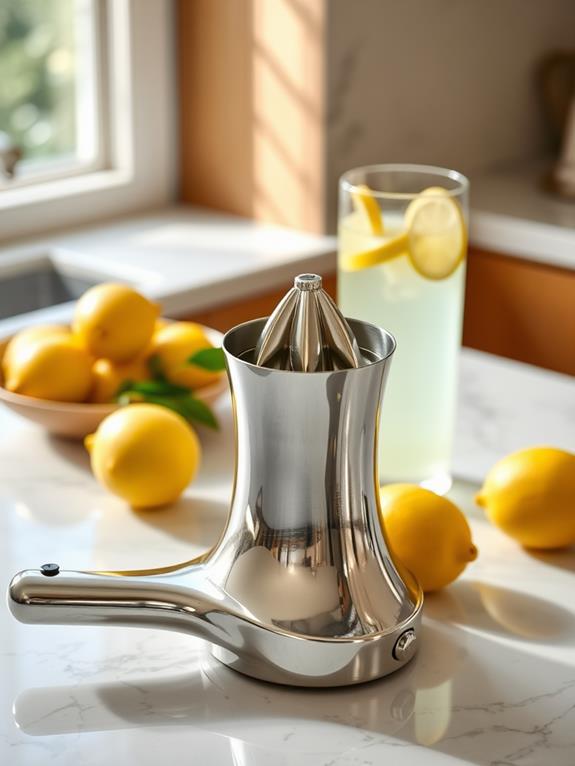
In light of their efficiency and ease of use, lemon squeezers offer numerous benefits to home cooks and professional chefs alike. When you use a lemon squeezer, you'll maximize juice extraction, getting more from each fruit than traditional methods. This efficiency means you'll need fewer lemons to achieve the same amount of juice, saving you time and money.
Modern lemon squeezers, often made from durable stainless steel, are built to last. You won't have to worry about rust or wear, ensuring your investment pays off in the long run. The ergonomic design of many models reduces hand fatigue, allowing you to squeeze multiple lemons without discomfort. This feature is particularly beneficial when preparing large batches of lemonade or cooking for a crowd.
Some lemon squeezers come equipped with a built-in seed catcher, preventing unwanted seeds from ending up in your dishes. This thoughtful addition enhances your overall juicing experience and saves you the trouble of fishing out seeds later. Finally, the ease of cleaning and maintenance makes lemon squeezers a convenient tool for your kitchen arsenal, often being dishwasher-safe for hassle-free cleanup.
Cleaning and Maintenance
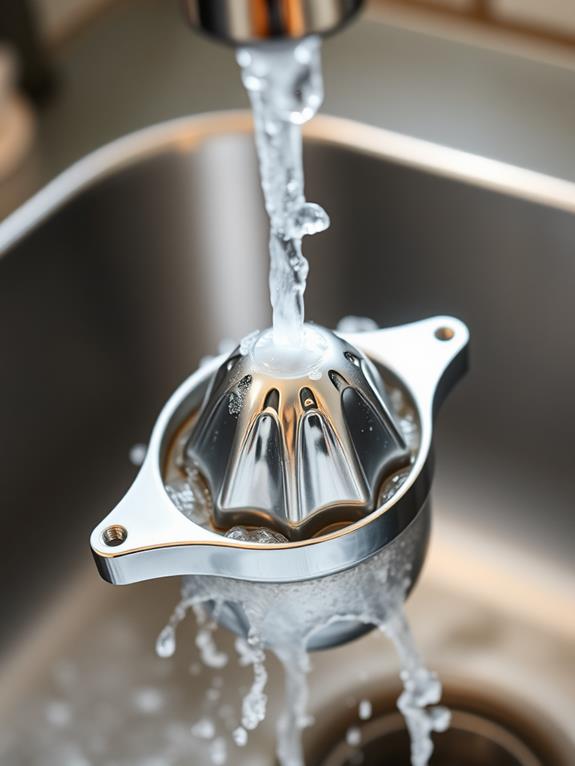
Proper cleaning and maintenance of your lemon squeezer will guarantee its longevity and peak performance. While many models, like those made from stainless steel, are dishwasher safe, hand washing is recommended to preserve durability and prevent smudges. After each use, rinse your squeezer with warm water and mild detergent, then dry it thoroughly to avoid water spots on the metal surface.
Regular cleaning is essential to maintain your juicer's efficiency. Here's a simple routine to follow:
- Rinse immediately after use to remove citrus residues
- Wipe down ergonomic handles with a damp cloth
- Inspect for signs of wear, especially if used frequently
For quick cleaning between uses, a simple rinse with warm water and mild soap will suffice. Pay attention to the anti-slip grips on the handles, as these areas can accumulate bacteria if not cleaned properly. Remember to dry your lemon squeezer completely after washing to prevent water spots and potential rusting.
Lastly, make it a habit to inspect your juicer regularly for any signs of wear or damage. This proactive approach will guarantee your lemon squeezer continues to function at its best for years to come.
Popular Brands and Models
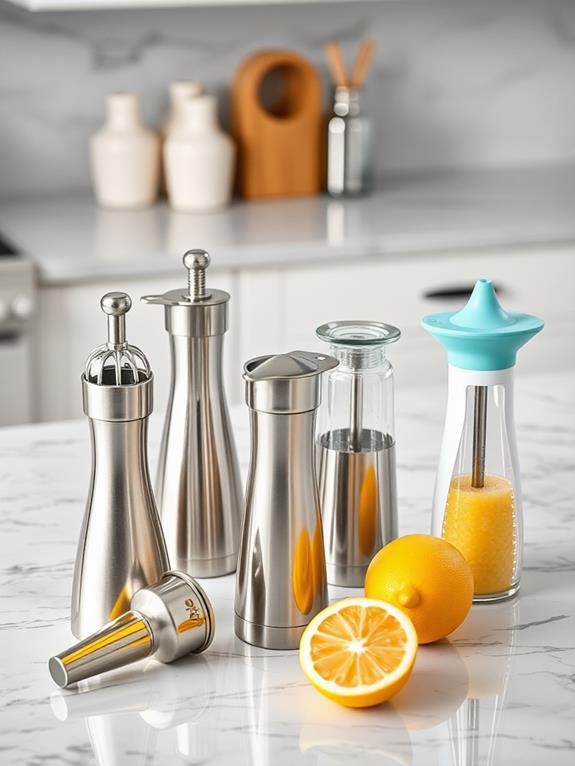
You'll find a wide array of top-rated citrus juicers on the market today, each with unique features designed to enhance your juicing experience. From iconic designs like Philippe Starck's Juicy Salif to practical options like Dxlac's HN-004 stainless steel squeezer, there's something for every preference and need. Innovative designs, such as Joseph Joseph's Catcher with its seed-filtering capability and Fluicer's compact, foldable triangular juicer, showcase how manufacturers are continuously improving this kitchen tool to make your juicing tasks easier and more efficient.
Top-Rated Citrus Juicers
Over the years, citrus juicers have evolved to offer a wide range of options for consumers. When looking for a top-rated lemon juicer, you'll find several standout models that combine functionality with innovative design. The Dxlac Lemon Squeezer, crafted from 304 stainless steel, boasts a polished finish and ergonomic design for effortless use and easy cleaning. If you're a cocktail enthusiast, you might be drawn to the Fluicer, which has gained popularity on social media for its triangular shape and built-in seed catcher.
For those who appreciate aesthetics, the iconic Juicy Salif by Philippe Starck offers a unique industrial design, though it prioritizes form over function. The Joseph Joseph Catcher, introduced in 2009, combines ergonomic design with seed-filtering capabilities, showcasing the ongoing innovation in citrus juicer functionality.
When choosing a lemon juicer, consider these key features:
- Material durability (e.g., stainless steel)
- Seed-filtering mechanism
- Ergonomic design for comfortable use
With over 200 U.S. patents filed for lemon squeezer designs between 1880-1910, you're sure to find a model that suits your specific needs and preferences.
Innovative Design Features
Innovative design features have revolutionized the world of lemon squeezers, transforming them from simple kitchen tools to conversation pieces. The Juicy Salif, designed by Philippe Starck in 1990, exemplifies this trend. Its striking aluminum form prioritizes aesthetics over functionality, sparking debate about the balance between form and function in kitchen gadgets.
You'll find that modern squeezer makes often combine style with practicality. Joseph Joseph's Catcher, for instance, filters out seeds while you juice, enhancing your experience. The Citrange by Royal VKB takes a playful approach with its double-sided design, adding an element of fun to your juicing routine.
For those who prefer innovative functionality, Lékue's Citrus Spray allows you to spritz fresh juice directly onto your dishes or drinks. This modern take on citrus juicing reflects a shift towards more versatile kitchen tools. If efficiency is your priority, Dxlac's stainless steel squeezer utilizes an 8-hole design to maximize juice extraction, particularly useful for larger fruits. These innovations demonstrate how designers are continually reimagining the humble lemon squeezer, balancing aesthetics, functionality, and user experience to create tools that are both practical and visually appealing.
Historical Evolution
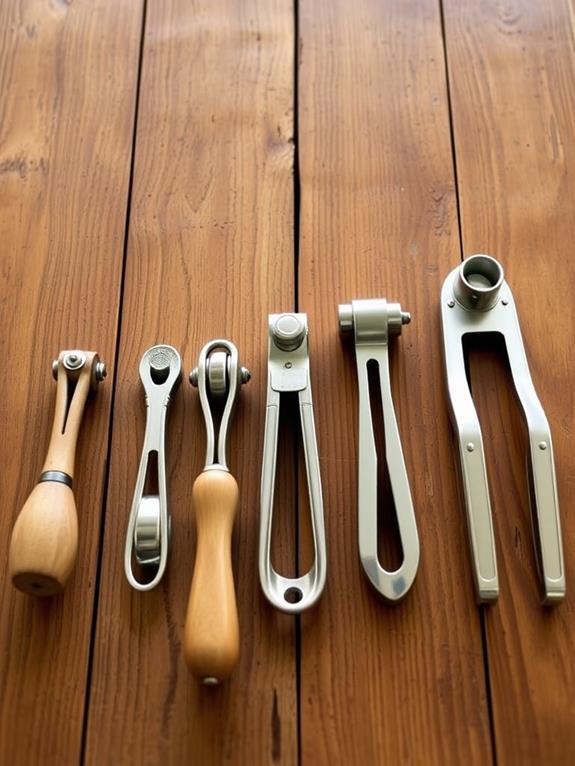
The humble lemon squeezer has a rich history dating back centuries. You might be surprised to learn that the oldest lemon squeezers weren't initially designed for juicing lemons at all. In fact, they were created for making sorbet in 18th-century Turkey. As the tool's popularity grew, inventors began filing patents for various lemon squeezer designs, particularly in the United States between 1880 and 1910.
The evolution of the lemon squeezer demonstrates how kitchen tools can adapt to meet changing needs and preferences. Here's a glimpse into its historical development:
- Early designs focused on applying pressure without rotating the fruit
- Over 200 patents were filed in just 30 years, showcasing rapid innovation
- Artistic designs, like the Juicy Salif, emerged in the late 20th century
Throughout history, lemon squeezers have played roles beyond the kitchen. At Trinity College, a wooden lemon squeezer has been part of celebrations since 1857, highlighting the cultural significance of this seemingly simple tool. From its humble beginnings to becoming a subject of artistic expression, the lemon squeezer's journey reflects our evolving relationship with kitchenware and food preparation.
Culinary Applications
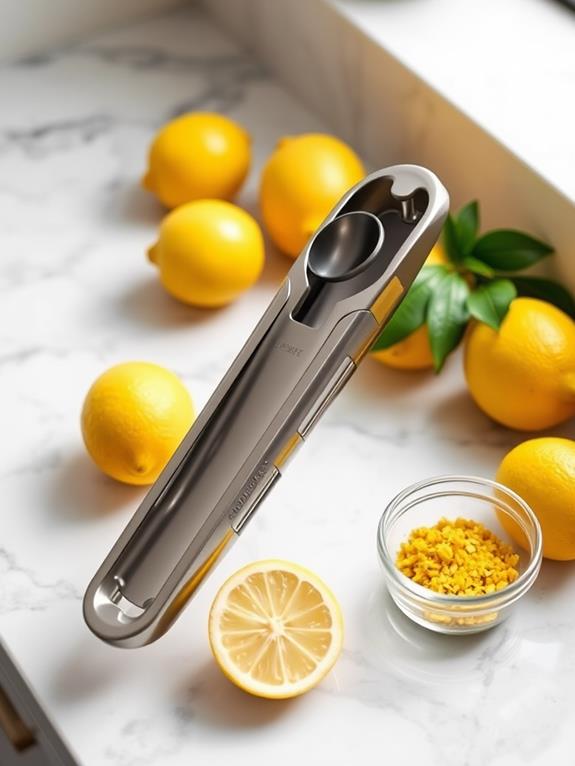
From its historical origins to modern kitchens, the lemon squeezer has become an indispensable tool for culinary enthusiasts and professional chefs alike. You'll find this versatile gadget enhancing flavors in a wide array of dishes and beverages. Whether you're whipping up a zesty vinaigrette, marinating seafood, or crafting the perfect cocktail, a lemon squeezer guarantees you extract every last drop of citrus goodness.
Modern lemon squeezers, like the Dxlac stainless steel model, boast ergonomic designs that make juicing a breeze. You'll appreciate the comfort and efficiency these tools offer, especially when preparing large batches. Some innovative models feature an 8-hole design that inverts the lemon peel during squeezing, maximizing juice extraction and minimizing waste.
As you explore culinary creativity, you'll discover that lemon juice is a key ingredient in countless recipes. From invigorating lemonades to tangy desserts, the possibilities are endless. The growing popularity of user-friendly kitchen gadgets like the Fluicer reflects a trend towards simplifying food preparation while encouraging the use of fresh ingredients. By incorporating a lemon squeezer into your culinary arsenal, you'll elevate your cooking and mixology skills with ease.
Choosing the Right Squeezer
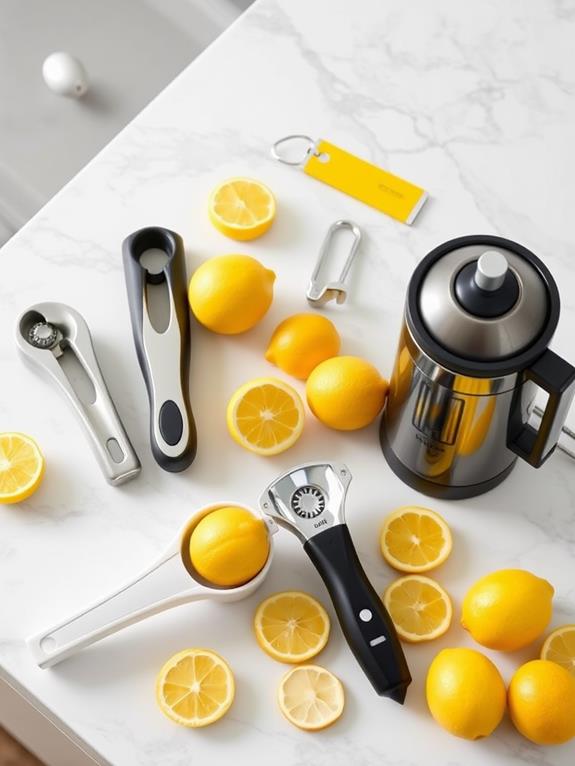
When you're in the market for a lemon squeezer, you'll want to contemplate three key factors: material and durability, size and capacity, and design features. Stainless steel options offer long-lasting performance, while the size of the squeezer should match the fruits you'll be juicing most often. Look for efficient designs with ergonomic handles, built-in seed catchers, and multiple holes to maximize juice extraction and ease of use.
Material and Durability Considerations
Choosing the right lemon squeezer hinges on understanding material and durability considerations. When selecting your kitchen tool, you'll want to focus on materials that offer longevity and ease of use. Stainless steel, particularly 304 grade, is a popular choice due to its corrosion resistance. This material guarantees your squeezer won't rust or deteriorate over time, even with frequent exposure to acidic citrus juices.
Consider these key factors when evaluating material and durability:
- Corrosion resistance of the main body
- Quality of handle materials (e.g., BPA-free plastic or silicone)
- Polished finishes for easy cleaning and maintenance
Don't overlook the importance of ergonomic design. Anti-slip silicone handles can considerably improve your grip and comfort during use. This feature is especially beneficial when you're juicing multiple lemons for recipes or beverages.
If you frequently work with larger citrus fruits, look for squeezers with wider openings and robust construction. These models can handle the extra pressure required for bigger lemons or even oranges. By prioritizing high-quality materials and thoughtful design, you'll invest in a lemon squeezer that withstands regular use and remains a reliable kitchen companion for years to come.
Size and Capacity Options
Now that you've considered material and durability, it's time to focus on size and capacity options for your lemon squeezer. When choosing the right squeezer, size matters. You'll want to select a model that accommodates the citrus fruits you use most often. Lemon squeezers come in various sizes, typically handling fruits up to 2.75 inches in diameter.
Consider the following table for guidance:
| Fruit Size | Squeezer Size | Typical Capacity |
|---|---|---|
| Small Limes | Compact | 0.25-0.3 liters |
| Medium Lemons | Standard | 0.4-0.5 liters |
| Large Lemons | Large | 0.5-0.6 liters |
| Medium Oranges | Extra Large | 0.6-0.7 liters |
Capacity is another significant factor. Some models offer a juice capacity of around 0.5 liters, allowing for substantial extraction in a single press. This is particularly useful if you're juicing multiple fruits at once. Additionally, consider the squeezer's weight. Standard manual lemon squeezers typically weigh between 10 to 14 ounces, making them easy to handle during use. Remember, choosing a squeezer that fits your preferred citrus size will maximize juice extraction and guarantee ease of operation.
Design and Efficiency Features
Plunge into the world of lemon squeezer design and efficiency features to find the perfect tool for your kitchen. When selecting a lemon squeezer, consider models with ergonomic shapes and anti-slip handles for comfortable use during citrus extraction. Look for squeezers with an 8-hole design, which maximizes juice extraction by inverting the lemon peel, ensuring you get the most out of each fruit.
For durability and longevity, opt for lemon squeezers made from high-quality materials like 304 stainless steel. These offer corrosion resistance and won't rust over time, making them a reliable choice for your kitchen. If space is a concern, consider compact and foldable designs that provide efficient squeezing while being easy to store.
To enhance your juicing experience, look for these key features:
- Built-in seed catchers to eliminate the need for separate seed removal
- Ergonomic handles for comfortable grip and reduced hand fatigue
- Multi-hole designs to maximize juice extraction from each lemon
Frequently Asked Questions
What Does Lemon Squeezer Mean in Slang?
In slang, "lemon squeezer" can have several meanings. You might hear it used to describe someone who's overly meticulous or exacting, often with a negative connotation. It can also refer to a person who's adept at extracting information or resources from others, much like squeezing juice from a lemon. Sometimes, it's used humorously to describe someone who's frugal or always trying to maximize limited resources. The term can also imply a persuasive individual who convinces others to give up more than they intended.
What Does Lemon Squeezer Mean on a Gun?
On a gun, a "lemon squeezer" refers to a specific type of revolver. You'll find this term used for firearms that require a firm, deliberate squeeze on the trigger, much like you'd squeeze a lemon. It's often associated with revolvers that have lighter triggers or unique pull mechanisms. This design emphasizes safety, as it helps prevent accidental discharges. You'll also hear gun enthusiasts use this term when discussing compact, easily concealable revolvers suitable for self-defense, drawing a parallel to the small, portable nature of a hand-held lemon squeezer.
What Is a Lemon Squeezer Workout?
Did you know that regular grip strength training can increase your forearm strength by up to 30%? The lemon squeezer workout is a functional exercise that targets your grip and forearm muscles. You'll mimic the action of squeezing a lemon, using hand grippers or a towel for resistance. It's great for improving hand dexterity and overall arm strength. You'll find this exercise particularly beneficial if you're into sports like rock climbing or gymnastics, where a strong grip is essential.
Why Is It Called a Lemon Squeezer?
You'll find that a lemon squeezer is aptly named for its primary function. It's called a "lemon squeezer" because you use it to squeeze lemons, extracting their juice. The term "squeezer" directly describes the action you perform when using the tool – you're compressing or squeezing the lemon to release its juice. This straightforward naming convention reflects the device's purpose, making it instantly recognizable. The name has stuck since the tool's invention in the 18th century, emphasizing its specific use for lemons.





